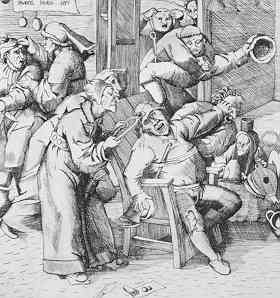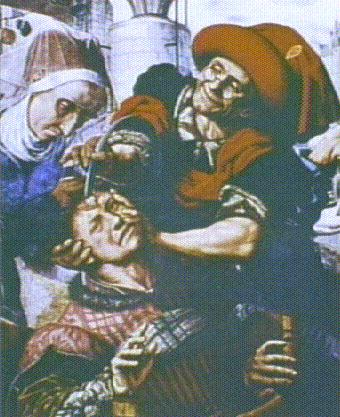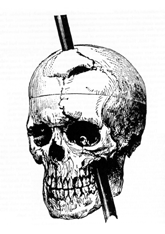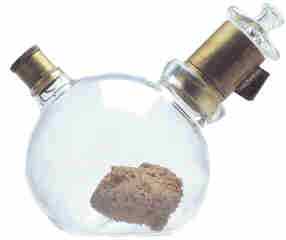

Before
the invention of anesthetics and the practice of asepsis, brain surgery was an awful mess. Historical records show
that surgery of the brain was practiced in Greece, by Hippocrates and his followers, in the Roman times (Galen
was thought to be a great brain surgeon), in the Arab world, by Medieval surgeons, well until the 18th century.
Most of the operations were performed for treating superficial tumors, fractures and brain trauma, especially those
caused by weapons (military surgery). However, most of the patients died. The delicate nature of the brain was
not made for the general principles of the general surgical skills of the time.
In addition, using bogus brain surgery to "treat" madness, epilepsy and other brain diseases, was very common among medical quacks for many centuries. For example, in the Medieval times, barbers-surgeons roamed the countryside offering a surgery for removing the "stone of madness" or "pierre de follie", which supposedly existed inside the skulls of mentally deranged people.


Thus, the brain remained for many centuries an almost forbidden territory for serious open surgery.
The road to scientific psychosurgery started with the discovery that certain parts of the brain controlled temperament, mood and intellect. In the second half of the 19th century, medical science was posed to amass a reasonable body of evidence that this was true. In opposition to the pseudoscientific ramblings of phrenology, proposed by the Franz Joseph Gall, biological experiments with lesions and stimulations of the brain of animals, were beginning to show the way on how to study scientifically the relations between brain and mind, for the first time.
Two bizarre and well publicized clinical cases, however, were fundamental in calling the attention of neurosurgeons to the effects of extensive lesion of a part of the brain, the prefrontal cortex. Both became classical cases in the neurology textbooks.
 The first was that of Phineas Gage, a young America railroad construction supervisor, who
underwent profound changes in mood and behavior following an accidental extensive lesion of the frontal part of
his brain when a steel rod traversed his skull. The findings about the Phineas Gage's case were later used to corroborate
the localization of frontal lobe tumors; and, by the turn of century, several operations had been performed on
the frontal lobes. thus indirectly leading to the development of lobotomy
by Egas Moniz, in 1936.
The first was that of Phineas Gage, a young America railroad construction supervisor, who
underwent profound changes in mood and behavior following an accidental extensive lesion of the frontal part of
his brain when a steel rod traversed his skull. The findings about the Phineas Gage's case were later used to corroborate
the localization of frontal lobe tumors; and, by the turn of century, several operations had been performed on
the frontal lobes. thus indirectly leading to the development of lobotomy
by Egas Moniz, in 1936.
The second was that of an institutionalized patient in Paris, France, who was known by the name of "Tan", which was the only word he could speak, following a syphillitic lesion of the frontal part of his left brain. He was studied by the brilliant physician Paul Pierre Broca, who was the first to determine the location of the speech center of the brain, in the third gyrus of the prefrontal cortex; what is now called Broca's area. This and other Broca's patient consolidated in neuroscience the view that the lesion of cirscumscribed areas of the brain could cause the loss of very specific mental or nervous functions in the human being.
The Amazing Case of Phineas Gage
Paul Pierre Broca: A Brief Biography

 Scientific neurosurgery
started for real in the 19th century. In Boston, in the Massachusetts General Hospital, the first surgery under
ether anesthesia was performed in 1867,
Scientific neurosurgery
started for real in the 19th century. In Boston, in the Massachusetts General Hospital, the first surgery under
ether anesthesia was performed in 1867,
William Macewen, a Scottish general surgeon, reported in 1893 on 19 patients that he operated for brain abscesses, 18 of whom were cured. In a time were antibiotics were unkown, this is a truly remarkable rate, a real revolution. He achieved this based on modern surgical techniques and post-operatory care. Macewen planned his first brain surgery based on the clinical observations of Paul Broca. Another great neurosurgeon, Victor A.H. Horsley, also developed many techniques and was very succesful in his field. Horsley also became an important predecessor of psychosurgery, due to his invention of the stereotactic technique and apparatus, in 1902. Although he developed the technique for animal experimentation, in the 40s several neurosurgeons, such as Ernst Spiegel, in the USA, and Lars Leksell, in Sweden, developed and used for the first time this technique in delicate, precise and minimally invasive brain surgery.
An American, Harvey Williams Cushing, considered the greatest neurosurgeon of the 20th century, consolidated neurosurgery as a specialty and developed a very influential school, with many important disciples from all over the world. From 1905 on, he advanced neurosurgery by developing a series of surgical techniques which are still in use today. He also wrote extensively.
Harvey Williams Cushing: A Brief Biography
Sir Victor Horsley: A Brief
Biography
 To
Know More
To
Know More
| From: The History of Psychosurgery Author: Renato M.E. Sabbatini, PhD Source: Brain & Mind Magazine, June 1997 |